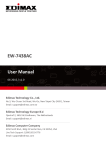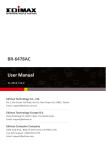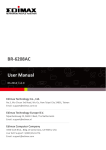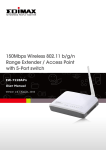Download Edimax AV500 Nano
Transcript
HP-5101Wn User Manual 03-2013 / v1.0 1 COPYRIGHT Copyright Edimax Technology Co., Ltd. all rights reserved. No part of this publication may be reproduced, transmitted, transcribed, stored in a retrieval system, or translated into any language or computer language, in any form or by any means, electronic, mechanical, magnetic, optical, chemical, manual or otherwise, without the prior written permission from Edimax Technology Co., Ltd. Edimax Technology Co., Ltd. makes no representations or warranties, either expressed or implied, with respect to the contents hereof and specifically disclaims any warranties, merchantability, or fitness for any particular purpose. Any software described in this manual is sold or licensed as is. Should the programs prove defective following their purchase, the buyer (and not this company, its distributor, or its dealer) assumes the entire cost of all necessary servicing, repair, and any incidental or consequential damages resulting from any defect in the software. Edimax Technology Co., Ltd. reserves the right to revise this publication and to make changes from time to time in the contents hereof without the obligation to notify any person of such revision or changes. The product you have purchased and the setup screen may appear slightly different from those shown in this QIG. For more information about this product, please refer to the user manual on the CD-ROM. The software and specifications are subject to change without notice. Please visit our website www.edimax.com for updates. All brand and product names mentioned in this manual are trademarks and/or registered trademarks of their respective holders. Edimax Technology Co., Ltd. Add: No. 3, Wu-Chuan 3rd Rd., Wu-Ku Industrial Park, New Taipei City, Taiwan Tel: +886-2-77396888 Email: [email protected] Notice According to GNU General Public License Version 2 This product includes software that is subject to the GNU General Public License version 2. The program is free software and distributed without any warranty of the author. We offer, valid for at least three years, to give you, for a charge no more than the costs of physically performing source distribution, a complete machine-readable copy of the corresponding source code. 2 I. CONTENTS PRODUCT INFORMATION......................................................................................... 5 I-1. Package Contents .....................................................................................................................5 I-2. I-3. I-4. I-5. Hardware .................................................................................................................................5 LED Status ................................................................................................................................6 Safety Information ...................................................................................................................7 System Requirements For Powerline Utility Software .............................................................7 II. CREATING A POWERLINE NETWORK ........................................................................ 8 II-1. II-2. II-3. II-4. II-5. Hardware Installation ..........................................................................................................8 iQ Setup .............................................................................................................................10 WPS Setup..............................................................................................................................15 Connecting to your HP-5101Wn ........................................................................................16 Leaving a Powerline Network ............................................................................................18 II-6. Resetting the Wireless Extender........................................................................................18 III. BROWSER BASED CONFIGURATION INTERFACE...................................................... 19 III-1. Home....................................................................................................................................21 III-2. iQ Setup ...............................................................................................................................23 III-3. Basic Setting .........................................................................................................................24 III-3-1. Security ............................................................................................................................26 III-3-1-1. Disable .........................................................................................................................27 III-3-1-1-1. 802.1x Authentication .................................................................................................27 III-3-1-2. WEP ..................................................................................................................................28 III-3-1-2. WPA Pre-shared Key.........................................................................................................29 III-3-1-3. WPA Radius ......................................................................................................................30 III-4. III-5. WPS Setting..........................................................................................................................32 Wireless Advanced...............................................................................................................34 III-5-1. MAC Filtering ...............................................................................................................36 III-6. System Utility ...............................................................................................................38 III-6-1. Time Setting .................................................................................................................41 III-6-2. Scheduling Setting ...........................................................................................................42 II-7. Configuration Tool................................................................................................................45 III-7-1. Diagnosis ..........................................................................................................................47 III-7-2. Firmware Upgrade ...........................................................................................................48 III-7-3. Reboot..............................................................................................................................49 IV. POWERLINE UTILITY SOFTWARE ............................................................................ 50 IV-1. IV-1.1 IV-1.2 IV-2. IV-2-1. IV-2-2. IV-2-3. Installation ...........................................................................................................................50 Win 8 ................................................................................................................................50 Win XP/Vista / 7 ...............................................................................................................59 Using the Utility Software.....................................................................................................65 Main Tab ............................................................................................................................65 Diagnostics Tab ..................................................................................................................66 About Tab ..........................................................................................................................67 V. APPENDIX .............................................................................................................. 68 3 V-1. Configuring your IP address .................................................................................................68 V-1-1. How to Configure Your Computer to Use a Dynamic IP Address .....................................68 V-1-1-1. Windows XP .................................................................................................................69 V-1-1-2. V-1-1-3. IV-1-1-4. V-1-1-5. V-1-2. V-1-2-1. V-1-2-2. V-1-2-3. V-1-2-4. V-1-2-5. Windows Vista .............................................................................................................70 Windows 7 ...................................................................................................................72 Windows 8 ...................................................................................................................74 Mac OS .........................................................................................................................78 How to Modify the IP Address of Your PC or Macintosh .................................................80 Windows XP .................................................................................................................80 Windows Vista .............................................................................................................81 Windows 7 ...................................................................................................................82 Windows 8 ...................................................................................................................84 Mac OS .........................................................................................................................88 V-1-3. V-1-3-1. V-1-3-2. How to Find Your Network Security Key ............................................................................90 Windows 7 & Windows Vista ......................................................................................90 Windows 8 ...................................................................................................................92 V-1-3-3. V-1-4. V-1-4-1. V-1-4-2. V-1-4-3. V-2. V-3. Mac ..............................................................................................................................95 How to Find Your Router’s IP Address ...............................................................................98 Windows XP, Vista & 7 .................................................................................................98 Windows 8 ...................................................................................................................99 Mac ............................................................................................................................101 Troubleshooting ...............................................................................................................103 Glossary ...........................................................................................................................105 4 I. PRODUCT INFORMATION Before you start using this product, please check if there is anything missing in the package, and contact your dealer to claim the missing items(s): I-1. Package Contents HP-5101Wn I-2. Ethernet Cable CD-ROM Quick Installation Guide Hardware WPS/Reset Button Ethernet Port Group Button Item Ethernet Port WPS/Reset Button Description Connects HP-5101Wn to a computer or other network device via Ethernet cable. Resets the HP-5101Wn to factory default settings or starts the WPS function. Reset: Press for over 10 seconds. WPS: Press for 2–5 seconds. 5 Group Button I-3. Groups the HP-5101Wn with other Powerline devices to establish an encrypted Powerline network. Press for less than 3 seconds to join/establish a network, and 5–8 seconds to leave a Powerline network. LED Status LED Color LED Status Flashing WLAN Green Off On WPS Green Flashing LAN Green PLC Green & Yellow Flashing WPS connection established (LED remains on for one minute after the connection is made). WPS in progress (waiting for another WPS device’s connection). No WPS in progress. On LAN port connected. Flashing Off Green with slow yellow flashing Green with rapid yellow flashing On Green No wireless activity. Off Off Power Description Wireless activity (transmitting or receiving data). LAN activity (transferring or receiving data). LAN port not connected. Detecting Powerline connection. Powerline activity (transferring or receiving data). No Powerline connection detected. HP-5101Wn is on. Flashing every The HP-5101Wn is in 15 seconds power-saving mode. Off 6 HP-5101Wn is off. I-4. Safety Information In order to ensure the safe operation of the device and its users, please read and act in accordance with the following safety instructions. 1. The wireless extender is designed for indoor use only; do not place the wireless extender outdoors. 2. Do not place the wireless extender in or near hot/humid places, such as a kitchen or bathroom. 3. Do not pull any connected cable with force; carefully disconnect it from the wireless extender. 5. The device contains small parts which are a danger to small children under 3 years old. Please keep the wireless extender out of reach of children. 6. Do not place the wireless extender on paper, cloth, or other flammable materials. The wireless extender will become hot during use. 7. There are no user-serviceable parts inside the wireless extender. If you experience problems with the wireless extender, please contact your dealer of purchase and ask for help. 8. The wireless extender is an electrical device and as such, if it becomes wet for any reason, do not attempt to touch it without switching the power supply off. Contact an experienced electrical technician for further help. 9. If you smell burning or see smoke coming from the wireless extender then unplug the extender immediately, as far as it is safely possible to do so. Call your dealer of purchase for help. I-5. System Requirements For Powerline Utility Software Operating System CPU RAM Free Disk Space Network Interface Utility supports Windows XP/Vista/7/8 Intel Pentium III 1.0GHz (or above) 256MB (or above) 100MB (or above) Ethernet port (100Mbps or above) and an Ethernet cable 7 II. CREATING A POWERLINE NETWORK A minimum of two Powerline devices are required to establish a Powerline network. For best performance, plug Powerline adapters directly into standard wall sockets. Avoid using multi-socket adapters. It may be convenient to install and configure your Powerline adapters in the same room, and then relocate the HP-5101Wn to its preferred location after setup is complete. II-1. Hardware Installation 1. Connect one Powerline adapter to your router via Ethernet cable and plug it into a power socket. The power and LAN LEDs should display on. 2. Plug another Powerline adapter (HP-5101Wn) into a power socket, and confirm the power LED is on. 3. The PLC LED on both Powerline adapters should indicate first that they are detecting a Powerline connection, and then that a Powerline connection is established. See LED Status for HP-5101Wn LEDs. 8 4. Press the “Group” button button on each Powerline adapter for less than 3 seconds, within 2 minutes of each other. The adapters will automatically group together and generate an encrypted network. You can now setup the HP-5101Wn’s Wi-Fi using either II-2. iQ Setup or II-3. WPS Setup. 9 II-2. iQ Setup 1. Use a Wi-Fi device (e.g. computer, tablet, smartphone) to search for a Wi-Fi network with the SSID “Edimax.Setup” and connect to it. SSID: Edimax.Setup 2. Open a web browser and if you do not automatically arrive at the “Get Started” screen shown below, enter the URL http://edimax.setup. Select your language from the drop down menu and click “Get Started” to begin the setup process. If you cannot access http://edimax.setup, please make sure your computer is set to use a dynamic IP address. If you are unsure, see V-1. Configuring your IP address. 10 3. Select “Obtain an IP address automatically” and then click “NEXT”. Advanced users who need to specify an IP address for the HP-5101Wn, select “Use the following IP address”. 4. Please wait a moment. 11 5. Please enter a “MAIN ESSID” – this is a name to identify the HP-5101Wn’s Wi-Fi network, which you will connect to from your wireless device. Then select a channel number (“Auto” is recommended) and enter a “Wi-Fi Security Password” between 8–64 characters, which is the password used to connect to the HP-5101Wn’s Wi-Fi network. Click “Next” to continue. Please do not forget your Wi-Fi password. If you do not wish to use a Wi-Fi password, check the box labeled “I don’t want to set up the Wi-Fi password”. 6. A summary of your HP-5101Wn’s Wi-Fi settings will be displayed, as shown below. Click “NEXT” to continue and restart your HP-5101Wn. 12 7. Please wait while the HP-5101Wn restarts. 8. When the HP-5101Wn has restarted, the following “Congratulations” screen will be displayed, indicating that wireless setup is complete. Your HP-5101Wn’s Wi-Fi should now be active and ready for use. If you need, you can relocate the HP-5101Wn to any power socket within 300m without additional configuration. 13 Refer to II-4. Connecting to your HP-5101Wn for help with connecting a Wi-Fi device to the extender’s Wi-Fi. 14 II-3. WPS Setup If your wireless router/access point supports WPS (Wi-Fi Protected Setup) then you can use this method to set up your HP-5101Wn’s Wi-Fi network. WPS is an alternative to II-2. iQ Setup. The HP-5101Wn’s Wi-Fi settings (including SSID) will be the same as your existing router/access point. 1. Press the WPS button (often the WPS/Reset button) on your router/access point to activate WPS. Please check the instructions for your wireless router/access point for how long you need to hold down its WPS button to activate WPS. Take care not to hold the WPS button for too long – this may result in inadvertently resetting the extender or router/access point. 2. Within two minutes, press and hold the WPS button for 2–5 seconds on the HP-5101Wn to activate its WPS. The HP-5101Wn’s WPS LED should flash to indicate a WPS connection is in progress. 3. The devices will establish a connection. The HP-5101Wn’s WPS LED should display on to indicate a successful connection. You can now connect to the HP-5101Wn’s wireless network with a Wi-Fi device, as described in II-4. Connecting to your HP-5101Wn. 15 II-4. Connecting to your HP-5101Wn The following steps 9-11 are an example of how to connect to a Wi-Fi network using Windows Vista. If you are using a different version of Windows, the process may vary slightly – please connect to a Wi-Fi network in the usual manner for operating system. 1. Click the network icon ( to a network”. , or ) in the system tray and select “Connect 2. Search for the SSID of your Wi-Fi network, click it and then click “Connect”. If you set a password for your network, you will then be prompted to enter it. 16 3. After correctly entering your password, you will be successfully connected to your Wi-Fi network. 4. You can also use the Ethernet port on the underside of the HP-5101Wn to connect a computer or other device via Ethernet cable. 17 II-5. Leaving a Powerline Network Press the Group/Reset button on the wireless extender for 5–8 seconds to leave a Powerline network that the extender is connected to. The extender will be disconnected/ungrouped from its network and ready to reconnect to any Powerline network. II-6. Resetting the Wireless Extender If you experience a problem with your HP-5101Wn you can reset the device back to its factory default settings. This resets all settings back to default. Press and hold the WPS/Reset button for at least 10 seconds. The HP-5101Wn will re-initialize and the power LED ( ) will display on when the extender is ready (see LED Status). 18 III. BROWSER BASED CONFIGURATION INTERFACE Once you have setup the wireless extender as detailed in II. CREATING A POWERLINE NETWORK or the included QIG, you can further configure the settings of the wireless extender or run iQ Setup again using the browser based configuration interface. To access the browser based configuration interface, enter http://edimax.setup into the URL bar of a web browser on a computer which is connected to the extender’s Wi-Fi network. You will be prompted for a username and password. The default username is “admin” and the default password is “1234”. You will arrive the at Home page, use the menu on the left side of the screen to navigate. You can also change the language using the drop down menu in the top right corner. 19 - III-1. Home - III-2. iQ Setup - III-3. Basic Setting - III-4. WPS Setting - III-5. Wireless Advanced - III-6. System Utility - III-7. Configuration Tool 20 III-1. Home The Home page shows the basic status and information of the wireless extender. The screenshots shown in this manual are examples. The information you see on your screen will be unique to your configuration. System Uptime Displays the total passed time since the device was turned 21 on. Hardware Version Displays the hardware version. Runtime Code Displays the current firmware version. Version Wireless Configuration Mode Displays the current wireless operating mode. ESSID Displays the current ESSID (the name used to identify the wireless extender). Channel Displays the current wireless channel number. Number Security Displays the current wireless security/encryption type. BSSID (MAC) Displays the device’s MAC address. A MAC address is a unique, fixed ID for this device which cannot be modified. Associated Displays the number of clients connected to the wireless Clients extender. Click the “Show Active Clients” button to display active clients in a new window (see below for full description): LAN Settings IP Address Subnet Mask Default Gateway MAC address Displays the IP address of this device. Displays the subnet mask of the IP address. Displays the IP address of the default gateway. Displays the MAC address of the LAN interface. Active Wireless Client Table MAC Address Displays the MAC address of the wireless client. Mode Displays the transmission mode (802.11b, 802.11n or 802.11g). Tx Packet Tx (transmission) packet counter. Rx Packet Rx (received) packet counter. Tx Rate (Mbps) Transmission rate is displayed here in Mbps. Power Saving “Yes” or “No” is displayed here according to whether power saving feature is active. Expired Time (s) If the wireless client is idle for longer than the expired 22 time, the access point will disassociate with it. When the wireless client becomes active, it will have to re-associate with the access point. III-2. iQ Setup To perform iQ Setup again and configure the Wi-Fi networks which the extender will connect to, select “iQ Setup”. You will see the screen below. Please click “Get Started” to begin iQ Setup and refer back to II. iQ Setup onwards for further guidance. 23 III-3. Basic Setting The “Basic Setting” page enables you to configure the ESSID, channel number and other basic parameters of the wireless extender. Mode Band The extender’s mode cannot be configured – the default mode is “Access Point”. The device acts as a wireless access point to a wired Ethernet network. Wireless clients can connect to the extender and exchange data with devices connected to the network. Select the wireless band you wish to use for the access point. The extender uses the 2.4GHz frequency band – select which wireless standard or combination of standards to use. Only wireless clients of the same 24 MAIN ESSID AP Isolation SSID Isolation Channel Number Associated Clients band(s) will be able to connect. Specify an ESSID (the name used to identify the access point) of up to up to 32 alphanumerical characters. Please note that the ESSID is case sensitive. When this is set to “Enabled”, wireless clients connected to this device will be able to access the Internet, but will not be able to communicate with each other. This applies to clients connected to the MAIN ESSID only. When the access point uses multiple SSIDs and this is set to “Enabled”, then wireless clients connected to the same SSID will be able to communicate with each other, but will not be able to communicate with other wireless clients connected to another of this access point’s SSIDs. You can input a numeric VLAD ID value between 1 – 4094 for the MAIN ESSID. Select a channel number for the wireless extender. Click the “Show Active Clients” button and a new window will appear which displays information about wireless clients connected to this access point. Click the “Refresh” button in the new window to refresh the list. Click “APPLY” to save the changes. The following message will appear: Click “CONTINUE” to save the changes and continue configuring other settings, or click “APPLY” to restart the system and make the changes take effect. 25 III-3-1. Security The wireless extender provides a variety of wireless security options (data encryption) which can be configured on this page. It is important to configure security to prevent intruders from accessing your local network and causing damage to computers and servers. Use complicated, hard-to-guess security keys which include combinations of letters and numbers and change your security key regularly. SSID choice Encryption Select which SSID’s security settings to configure. Select an encryption type from the drop down menu and refer to the appropriate section (following) for more details. WPA pre-shared key offers the highest level of security and is the recommended encryption type. 26 III-3-1-1. Disable Select “Disable” to disable wireless encryption for the network. This is not recommended - anyone within range can connect to the device’s SSID. Enable 802.1x Authentication Check this box to enable 802.1x user authentication. See below. III-3-1-1-1. 802.1x Authentication If you select “Disable” or “WEP” as your encryption type, you can check the “Enable 802.1x Authentication” box to enable 802.1x authentication based on a RADIUS user authentication server. RADIUS Server IP Address RADIUS Server Port RADIUS Server Password Enter the IP address of the RADIUS authentication server here. Enter the port number of the RADIUS authentication server here. Default value is 1812. Enter the password of the RADIUS authentication server here. Click “APPLY” to save the changes. The following message will appear: Click “CONTINUE” to save the changes and continue configuring other settings, or click “APPLY” to restart the system and make the changes take effect. 27 III-3-1-2. WEP Wired Equivalent Privacy (WEP) is a basic encryption type. WPA encryption is recommended – though some legacy wireless devices may only support WEP. WEP supports data rates up to a maximum 54Mbps. Key Length Key Format Default Key Encryption Key 1 to 4 Enable 802.1x Authentication Select “64-bit” or “128-bit” key length. “128-bit” is safer than “64-bit” but will reduce some data transfer performance. Select “ASCII” or “Hex” key format. The key length will also be displayed here - ASCII and Hex keys vary in length depending on “Key Length” (above)”. The value for “Default Key” is “Key 1” and cannot be modified. Enter WEP key here, the number of characters must be the same as the number displayed in the “Key Format” field. For “ASCII” key format, you can use any alphanumerical characters (0-9, a-z, and A-Z). For “Hex” format, you can use the characters 0-9, a-f, and A-F. Check this box to enable 802.1x user authentication. See III-1-1-1. Enable 802.1x Authentication. Click “APPLY” to save the changes. The following message will appear: 28 Click “CONTINUE” to save the changes and continue configuring other settings, or click “APPLY” to restart the system and make the changes take effect. III-3-1-2. WPA Pre-shared Key WPA pre-shared key is the recommended and most secure encryption type. WPA Unicast Cipher Suite Pre-shared Key Format Pre-shared Key Select from WPA (TKIP), WPA2 (AES) or WPA2 Mixed. AES is safer than TKIP, but not supported by all wireless clients. WPA2(AES) or WPA2 is recommended if supported by your wireless client. Mixed is recommended if your client does not support AES. Select the pre-shared key format from “Passphrase” (8 to 63 alphanumerical characters) or “Hex (64 characters 0 to 9 and a to f.) Please enter the key according to the key format you selected above. For security reasons, it’s best to use a complex, hard-to-guess key. TKIP supports a maximum data rate of 54Mbps. Click “APPLY” to save the changes. The following message will appear: 29 Click “CONTINUE” to save the changes and continue configuring other settings, or click “APPLY” to restart the system and make the changes take effect. III-3-1-3. WPA Radius WPA RADIUS is a combination of WPA encryption and RADIUS user authentication. If you have a RADIUS authentication server, you can authenticate the identity of every wireless client against a user database. WPA Unicast Cipher Suite RADIUS Server IP address RADIUS Server Port RADIUS Server Password Select from WPA (TKIP), WPA2 (AES) or WPA2 Mixed. AES is safer than TKIP, but not supported by all wireless clients. WPA2(AES) or WPA2 is recommended if supported by your wireless client. Mixed is recommended if your client does not support AES. Enter the IP address of the RADIUS authentication server here. Enter the port number of the RADIUS authentication server here. Default value is 1812. Enter the password of the RADIUS authentication server here. Click “APPLY” to save the changes. The following message will appear: 30 Click “CONTINUE” to save the changes and continue configuring other settings, or click “APPLY” to restart the system and make the changes take effect. 31 III-4. WPS Setting WPS (Wi-Fi Protected Setup) is a simple way to establish connections between WPS compatible devices. WPS devices feature a WPS function which can be activated by pushing a WPS button on the device or from within the device’s firmware/configuration interface. When WPS is activated in the correct manner and at the correct time for two compatible devices, they will automatically connect. By default, the WPS Settings page displays settings for WPS between your extender and a wireless client. For WPS Setup between your extender and router/access point, please refer back to (II-3. WPS Setup). The wireless extender supports two types of WPS for wireless clients: PBC (Push Button Configuration) and PIN code. For PBC you can activate WPS on the wireless extender by clicking the “Start PBC” button on the screen. 32 Click the “Start PBC” button to activate WPS – do not push the WPS/Reset button on the extender. PIN code setup varies slightly in that it requires you to manually enter a PIN code into each device via the WPS Settings before activating WPS. WPS Status Device PIN Code Displays “Configured” or “unConfigured” depending on whether WPS Settings for the extender have been configured or not, either manually or using the WPS button. This is the WPS PIN code of the wireless extender for use with other WPS-enabled wireless devices. SSID Displays the current SSID (the name used to identify the wireless extender). Authentication Mode Displays the current wireless security/encryption type. Passphrase Key Shows the WPA passphrase here, though all characters will be replaced by asterisks for security reasons. If encryption is not set on the access point, this field will be blank. The configuration mode of the extender’s WPS setting is displayed here. “Registrar” means the device acts as an access point for a wireless client to connect to and the wireless client(s) will follow the extender’s wireless settings. “Enrollee” means the device acts a wireless client and will follow the settings of the wireless router/access point. Click “Start PBC” to activate WPS on the extender. Config Mode Configure via Push Button Input Client PIN Code Input the wireless client’s PIN code here and click “Start PIN” to activate PIN code WPS. Refer to your wireless client’s documentation if you are unsure of its PIN code. The WPS LED ( ) will flash slowly to indicate WPS is active. WPS will remain active for two minutes. Within two minutes, activate WPS on your client device (refer to client device’s user manual for guidance on how to do so) in order to establish a connection. The WPS LED ( ) will display ON to indicate a successful connection, and will remain ON for 5 minutes (see I-3. LED Status). 33 III-5. Wireless Advanced In “Advanced Setting” you can configure the advanced features of the wireless extender. Please do not modify these settings unless you know what effect the changes will have on your access point; advanced settings are for experienced users only. Changing these settings can adversely affect the performance of your wireless extender. 34 Fragment Threshold RTS Threshold Beacon Interval DTIM Period Data Rate N Data Rate Channel Width Preamble Type Broadcast ESSID WMM CTS Protect TX Power Set the fragment threshold of the wireless radio. The default value is “2346”. Set the RTS threshold of the wireless radio. The default value is “2347”. Set the beacon interval of the wireless radio. The default value is “100”. Set the DTIM period of wireless radio. The default value is “3”. Set the wireless data transfer rate. The default value is “Auto”. Set the data rate of 802.11n. The default value is “Auto”. Select wireless channel width. Set the wireless radio preamble type. Set if the access point will broadcast its own ESSID. To hide the ESSID of your extender select “Disable” - only users who know the ESSID of your access point will be able to connect. WMM (Wi-Fi Multimedia) technology can improve the performance of certain network applications, such as audio/video streaming, network telephony (VoIP), and others. When WMM is enabled, the extender will prioritize different kinds of data and give higher priority to applications which require instant responses. This improves the performance of such network applications. Enabling this setting will reduce the chance of radio signal collisions between 802.11b and 802.11g wireless access points. It’s recommended to set this option to “Auto”. Set the power output of the wireless radio. Setting a lower power output, provided it is still sufficient for your range requirements, can potentially improve security since malicious/unknown users in distant areas will not be able to access your signal. Click “APPLY” to save the changes. The following message will appear: 35 Click “CONTINUE” to save the changes and continue configuring other settings, or click “APPLY” to restart the system and make the changes take effect. III-5-1. MAC Filtering The MAC filtering feature allows you to define a list of wireless devices permitted to connect to this access point, identified by their unique MAC address. When a device which is not listed as a permitted MAC address attempts to connect to the extender, it will be denied. Check the box “Enable Wireless Access Control” box to enables MAC address filtering. 36 Select SSID Select which SSID to configure. MAC Address Filtering Table: Select Delete Selected Delete All Reset Enable Wireless Access Control MAC address Comment Add Clear Check this box to select MAC address(es). Click this button to delete selected MAC address(es). Delete all MAC addresses in the table. Uncheck all selected MAC address entries. Check this box to enable MAC address filtering. Enter a MAC address permitted to connect to the extender. Only enter characters 0 to 9 or a to f. Enter an optional comment associated with the specified MAC address for reference/identification, consisting of up to 16 alphanumerical characters. Add the MAC address entry to the list. Remove all characters in the “MAC address” and “Comments” fields. Click “APPLY” to save the changes. The following message will appear: 37 Click “CONTINUE” to save the changes and continue configuring other settings, or click “APPLY” to restart the system and make the changes take effect. III-6. System Utility In “System Utility” you can configure the extender’s administrative password and manage the extender’s IP and DHCP settings. You can change the password used to login to the browser-based configuration interface here. It is advised to do so for security purposes. 38 Current Password New Password Re-Enter Password Enter your current password. The default password is 1234. Enter your desired new password here. You can use any combination of letters, numbers and symbols up to 20 characters. Confirm your new password. You can modify the IP address of the extender, enabling it to become a part of your local area network. To do so, input the IP address, subnet mask and gateway address into the corresponding fields. IP Address Subnet Mask Gateway Address DHCP Server Specify an IP address here. This IP address will be assigned to your extender, and will replace the default IP address 192.168.10.1. Input the subnet mask of the new IP address. Input the network’s gateway IP address. Select “Enabled” if you wish to use the DHCP function of the extender, as detailed below. Please write down and remember the new IP address you assigned to the wireless extender. If you forget this IP address 39 you may not be able to connect to the browser-based configuration interface in the future. For static IP users, the wireless extender needs to have an IP address in the same subnet as your network, in order that you can access the browser based configuration interface. For example, if your static IP is 192.168.9.2 then you need to assign the wireless extender an IP address in the range 192.168.9.x where x = 3–254. Each network device has a unique IP address. To ensure that you assign a correct IP address to the wireless extender, you can also check the IP address of your router. Please refer to V-1-4. How to Find your Router’s IP Address. Your ISP can also provide you with such information as IP address, subnet mask and gateway address. If you are unable to connect to the browser based configuration interface using http://edimax.setup, it is possible that you assigned an incorrect IP address to the extender. In this case you can reset the wireless extender back to its default IP address. See II-4. Resetting The Wireless Extender. The extender can be configured to act as a DHCP server for your network. By default DHCP is disabled. Enable DHCP by selecting “Enable” in the field “DHCP Server”. Default Gateway Domain Name Server IP Start IP End IP Domain Name Lease Time Specify the IP address of the default gateway of your network here. Input the IP address of the domain name server (DNS). Input the start address of the IP range. Input the end address of the IP range. Input the domain name for your network (optional). Choose a lease time (the duration that every computer can keep a specific IP address) of every IP address assigned by the extender. Click “APPLY” to save the changes. The following message will appear: 40 Click “CONTINUE” to save the changes and continue configuring other settings, or click “APPLY” to restart the system and make the changes take effect. III-6-1. Time Setting You can configure the time settings of your wireless extender here. The date and time of the device can be configured manually or can be synchronized with a time server. 41 Time Zone Select the time zone of your country/ region. If your country/region is not listed, please select another country/region whose time zone is the same as yours. Time Server Address The extender supports NTP (Network Time Protocol) for automatic time and date setup. Input the host name or IP address of the IP server manually. Daylight Savings If your country/region uses daylight saving time, please check the “Enable Function” box and select the start and end date. Click “APPLY” to save the changes. The following message will appear: Click “CONTINUE” to save the changes and continue configuring other settings, or click “APPLY” to restart the system and make the changes take effect. III-6-2. Scheduling Setting The wireless extender includes a scheduling function, where power saving functions and an automatic reboot can be automated for specific times. By default, scheduling setting is disabled. Please select “Enable” if you wish to continue. 42 Click “Add” to open a new window and create a new scheduled event. Ensure that you have correctly configured the time settings of your wireless extender before enabling the scheduling function. 43 Service Select the type of event to be scheduled. “Wireless off” will switch off wireless and “Auto reboot” will restart the device. Schedule Description Assign the event an optional name or description for reference. Start Time Specify a start time (hh.mm) for the event on one or more specified days. End Time Specify an end time (hh.mm) for the event, for a specific day or to recur every day. Select Check the box to select and confirm your event. Click “Save” to save your scheduled event and then click “OK”. The scheduled event should now be listed. Up to 10 events can be scheduled. Edit Delete Select the type of event to be scheduled. “Wireless off” will switch off wireless and “Auto reboot” will restart the device. Assign the event an optional name or description for reference. Click “APPLY” to save the changes. The following message will appear: 44 Click “CONTINUE” to save the changes and continue configuring other settings, or click “APPLY” to restart the system and make the changes take effect. II-7. Configuration Tool On the configuration tool page you can backup the extender’s current settings, restore the settings to a previously saved version or reset the extender back to it’s original, factory default state. Restoring settings to the factory default will restore all settings, configurations and passwords back to the factory default. 45 You can also reset the device to factory defaults by pressing and holding the Reset/WPS button for at least 10 seconds. See II-3. Resetting The Wireless Extender. Backup Settings Restore Settings Restore to Factory Defaults Click “Save” to save the current settings of the extender as a config.bin file to your specified location. Click the browse button to locate a previously saved config.bin file and then click “Upload” to upload the file and replace your current settings. Click “Reset” to restore settings to the factory default. A pop-up window will appear and ask you to confirm, please click “Ok” and the extender will restart. A status bar will indicate the progress of the restart. 46 III-7-1. Diagnosis Using the diagnosis tool, you can ping a specific IP address and automatically reboot the device if there is no response. Watchdog and reboot device Ping address Time interval Select “Enable” or “Disable” for the automatic reboot function. Specify the IP address to ping. Specify the frequency of the ping as a time interval, in minutes. Enter a value from 1-60. 47 III-7-2. Firmware Upgrade The wireless extender’s firmware upgrade feature allows you to upgrade the system firmware to a more recent version. You can download the latest firmware from the Edimax website. Do not switch off or disconnect the access point during a firmware upgrade, as this could damage the device. It is recommended that you use a wired Ethernet connection to upload the firmware file. Browse CANCEL APPLY Click “Browse” to open a window and locate the firmware file. Click “CANCEL” to cancel and clear the selected file from the “Browse” box. Click “APPLY” to upgrade to the selected firmware file. A pop up window will ask you to confirm, and inform you that the device may not respond for up to a minute after the upgrade. Please click “OK”. A status bar will show the progress of the upgrade. 48 III-7-3. Reboot If the wireless extender malfunctions or is not responding, then it is recommended that you reset the device. This feature is useful if the location of the access point is not convenient to physically use the hardware reset button. A system reboot will restart the device without affecting existing settings. If the wireless extender is still not responding after a reset, then switch off the device by disconnecting the power supply and wait for 10 seconds before reconnecting the power. APPLY Click “APPLY” to reboot the system. You will be asked to confirm, and informed that the reboot may take a while. A status bar will indicate the progress.. 49 IV. POWERLINE UTILITY SOFTWARE The included CD-ROM contains Powerline utility software, which enables you to manage and configure your Powerline network in more detail. The utility enables you to manage all connected Powerline adapters. IV-1. Installation Before installating the utility software, please uninstall any existing Powerline utility software you may already have. To install the utility software, insert the CD into your CD-ROM drive and the setup wizard should begin automatically. If not, please manually locate and open the “AutoRun.exe” file in the CD. IV-1.1 Win 8 Step 1 Before installing the utility software, make sure that no other powerline utility is installed on your computer. If any other utility software is installed, uninstall it and reboot the computer. Step 2 Insert the CD into your CD-ROM drive. When the following EZmax Wizard appears, select your model. 50 Step 3 Then click “Setup Utility”. 51 Step 4 Click right button on WinPCap4.1.2 then click “Properties”. Step 5 Click Compatibility tab and check “Run this program in compatibility mode for:", then select Windows 7, then click “Apply”. 52 Step 6 Then click “WinPcap_4_1_2”. The wizard will guide you through the setup process. 53 Step 7 When the following WinPcap Compatibility Assistant appears, select Run the program without getting help. 54 Step 8 After the installation is complete, click “Finish”. 55 Step 9 Click the “Edimax PowerLine Utility”, the “PLC 500Mbps Utility” appears, click “Next” to continue. 56 Step 10 Select where you want to install the utility software, and then click “Next”. Step 11 After the installation is complete, click “Close”. 57 Step 12 An icon will appear on your desktop. Click the icon to open the utility software. Note: You can manage all the connected powerline adapters with the utility software. However, installing the utility software is optional. 58 IV-1.2 Win XP/Vista / 7 Step 1 Before installing the utility software, make sure that no other powerline utility is installed on your computer. If any other utility software is installed, uninstall it and reboot the computer. Step 2 Insert the CD into your CD-ROM drive. When the following EZmax Wizard appears, select your model. Step 3 Then click “Setup Utility”. 59 Step 4 If you have not installed WinPcap version 4.1.2 (or higher) on your computer before. The wizard will guide you through the setup process. 60 61 Step 5 When the “Edimax PowerLine Utility” setup wizard appears, click “Next” to continue. Step 6 In the “License Agreement” screen, please select “I Agree” and then click “Next” to continue. 62 Step 7 Select where you want to install the utility software, and then click “Next”. Step 8 If you confirm to install the utility, click “Next”. 63 Step 9 After the installation is complete, click “Close”. Step 10 An icon will appear on your desktop. Click the icon to open the utility software. Note: You can manage all the connected powerline adapters with the utility software. However, installing the utility software is optional. 64 IV-2. Using the Utility Software IV-2-1. Main Tab The “Main” tab provides a list of powerline adapters connected to the network. The upper panel displays local powerline adapters. The lower panel displays remote powerline adapters in the network. Set Name Enter Password Scan Select a device and click “Set Name” to rename the device. By default, this column is blank. Select a device and click “Enter Password” to set up a password for the device. Click “Scan” and the utility software will perform an immediate scan of other remote powerline adapters. By default, the utility automatically scans every few seconds. 65 IV-2-2. Diagnostics Tab The “Diagnostics” tab displays the system information and history of all remote devices. The upper panel displays technical data concerning the software and hardware on the host computer and the lower panel displays the history of all remote devices. 66 IV-2-3. About Tab The “About” tab contains some basic information about the software. You can also enable or disable the autoscan function under “Preferences”. 67 V. APPENDIX V-1. Configuring your IP address Before you use the wireless extender, please make sure your computer is set to use a dynamic IP address. This means your computer can obtain an IP address automatically from a DHCP server. This is a simple procedure, which is explained step by step in V-1-1. How to configure your computer to use a dynamic IP address. Static IP users, please make a note of your static IP before you change it or switch to a dynamic IP address. Unfortunately, not all networks support DHCP capability. In this case, you need to use a static IP address for the wireless extender and your PC or Macintosh. The wireless extender uses the default IP address 192.168.10.1, which may not be in the same IP address subnet of your network; meaning you are unable to access the browser based configuration interface. So, you need to modify the IP address of your PC or Macintosh to 192.168.10.x (x = 2 – 254) in order to access the browser-based configuration interface. The procedure for doing so varies across different operating systems; please follow the guide appropriate for your operating system in IV-1-2. How to modify the IP address of your PC or Macintosh. Note: For guidance on how to assign a new IP address to the wireless extender, so that it is within the same IP address subnet of your network, please refer to III-6. System Utility. In cases where you need to modify the IP of your PC or Macintosh in order to access the browser based configuration interface, if the default IP of the wireless extender remains unchanged, you may need to repeat this process and modify the IP of your PC or Macintosh every time you wish to configure the wireless extender. V-1-1. How to Configure Your Computer to Use a Dynamic IP Address Please follow the instructions appropriate for your operating system. 68 V-1-1-1. Windows XP 1. Click the “Start” button (it should be located in the lower-left corner of your computer), then click “Control Panel”. Double-click the “Network and Internet Connections” icon, click “Network Connections”, and then double-click “Local Area Connection”. The “Local Area Connection Status” window will then appear, click “Properties”. 2. Select “Obtain an IP address automatically” and “Obtain DNS server address automatically”, then click “OK”. 69 V-1-1-2. Windows Vista 1. Click the “Start” button (it should be located in the lower-left corner of your computer), then click “Control Panel”. Click “View Network Status and Tasks”, then click “Manage Network Connections”. Right-click “Local Area Network”, then select “Properties”. The “Local Area Connection Properties” window will then appear, select “Internet Protocol Version 4 (TCP / IPv4)”, and then click “Properties”. 70 2. Select “Obtain an IP address automatically” and “Obtain DNS server address automatically”, then click “OK”. 71 V-1-1-3. Windows 7 1. Click the “Start” button (it should be located in the lower-left corner of your computer), then click “Control Panel”. 2. Under “Network and Internet” click “View network status and tasks”. 3. Click “Local Area Connection”. 72 4. Click “Properties”. 5. Select “Internet Protocol Version 4 (TCP/IPv6) and then click “Properties”. 73 3. Select “Obtain an IP address automatically” and “Obtain DNS server address automatically”, then click “OK”. IV-1-1-4. Windows 8 1. From the Windows 8 Start screen, you need to switch to desktop mode. Move your curser to the bottom left of the screen and click. 74 2. In desktop mode, click the File Explorer icon in the bottom left of the screen, as shown below. 3. Right click “Network” and then select “Properties”. 75 4. In the window that opens, select “Change adapter settings” from the left side. 5. Choose your connection and right click, then select “Properties”. 76 6. Select “Internet Protocol Version 4 (TCP/IPv6) and then click “Properties”. 4. Select “Obtain an IP address automatically” and “Obtain DNS server address automatically”, then click “OK”. 77 V-1-1-5. Mac OS Note: Please ensure that your wireless extender is switched on and connected to your Macintosh via Ethernet cable before you begin. 1. Have your Macintosh computer operate as usual, and click on “System Preferences”. 2. In System Preferences, click on “Network”. 78 3. Here you will see all of your network connections. Network Preferences will now display an Ethernet adapter, as shown below. The status of “Ethernet” should be “Connected”. 4. Click on “Ethernet” in the left panel and then click the drop down arrow for the menu labeled “Configure IPv4” in the right panel. From the drop down menu, select “Using DHCP” and then click “Apply”. 79 V-1-2. How to Modify the IP Address of Your PC or Macintosh Please follow the instructions appropriate for your operating system. In the following examples we use the IP address 192.168.10.20 though you can use any IP address in the range 192.168.9.x (x = 3 – 254) in order to access the browser based configuration interface. Note: Please make a note of your static IP before you change it. This is for your convenience if you wish to modify the IP address of the wireless extender in future. To modify the IP address of the wireless extender, please refer to III-6. System Utility. V-1-2-1. Windows XP 1. Click the “Start” button (it should be located in the lower-left corner of your computer), then click “Control Panel”. Double-click the “Network and Internet Connections” icon, click “Network Connections”, and then double-click “Local Area Connection”. The “Local Area Connection Status” window will then appear, click “Properties”. 2. Select “Use the following IP address”, then input the following values: 80 Note: Your existing static IP address will be displayed in the “IP address” field before you replace it. Please make a note of this IP address, subnet mask, default gateway and DNS server addresses. IP address: 192.168.10.20 Subnet Mask: 255.255.255.0 Click ‘OK’ when finished. V-1-2-2. Windows Vista 1. Click the “Start” button (it should be located in the lower-left corner of your computer), then click “Control Panel”. Click “View Network Status and Tasks”, then click “Manage Network Connections”. Right-click “Local Area Network”, then select “Properties”. The “Local Area Connection Properties” window will then appear, select “Internet Protocol Version 4 (TCP / IPv4)”, and then click “Properties”. 2. Select “Use the following IP address”, then input the following values: 81 Note: Your existing static IP address will be displayed in the “IP address” field before you replace it. Please make a note of this IP address, subnet mask, default gateway and DNS server addresses. IP address: 192.168.10.20 Subnet Mask: 255.255.255.0 Click ‘OK’ when finished. V-1-2-3. Windows 7 1. Click the “Start” button (it should be located in the lower-left corner of your computer), then click “Control Panel”. 2. Under “Network and Internet” click “View network status and tasks”. 82 3. Click “Local Area Connection”. 4. Click “Properties”. 83 5. Select “Internet Protocol Version 4 (TCP/IPv6) and then click “Properties”. 6. Select “Use the following IP address”, then input the following values: Note: Your existing static IP address will be displayed in the “IP address” field before you replace it. Please make a note of this IP address, subnet mask, default gateway and DNS server addresses. IP address: 192.168.10.20 Subnet Mask: 255.255.255.0 Click ‘OK’ when finished. V-1-2-4. Windows 8 1. From the Windows 8 Start screen, you need to switch to desktop mode. Move your curser to the bottom left of the screen and click. 84 2. In desktop mode, click the File Explorer icon in the bottom left of the screen, as shown below. 3. Right click “Network” and then select “Properties”. 85 4. In the window that opens, select “Change adapter settings” from the left side. 5. Choose your connection and right click, then select “Properties”. 86 6. Select “Internet Protocol Version 4 (TCP/IPv4) and then click “Properties”. 7. Select “Use the following IP address”, then input the following values: 87 Note: Your existing static IP address will be displayed in the “IP address” field before you replace it. Please make a note of this IP address, subnet mask, default gateway and DNS server addresses. IP address: 192.168.10.20 Subnet Mask: 255.255.255.0 Click ‘OK’ when finished. V-1-2-5. Mac OS Note: Please ensure that your wireless extender is switched on and connected to your Macintosh via Ethernet cable before you begin. 1. Have your Macintosh computer operate as usual, and click on “System Preferences” 2. In System Preferences, click on “Network”. 3. Here you will see all of your network connections. Network Preferences will now display an Ethernet adapter, as shown below. The status of “Ethernet” should be “Connected”. 88 4. Click on “Ethernet” in the left panel and then click the drop down arrow for the menu labeled “Configure IPv4” in the right panel. From the drop down menu, select “Manually”. 5. In the panel on the right side, enter IP address 192.168.10.20 and subnet mask 255.255.255.0. Click on “Apply”. 89 Note: Your existing static IP address will be displayed in the “IP address” field before you replace it. Please make a note of this IP address, subnet mask, router IP and DNS server address. 6. In the left sidebar, “Ethernet” should now display “Connected” as shown below. In the right panel, you should see the IP address 192.168.10.20 and subnet mask 255.255.255.0. V-1-3. How to Find Your Network Security Key To find your network security key, please follow the instructions appropriate for your operating system. Note: If you are using Windows XP or earlier, please contact your ISP or router manufacturer to find your network security key. V-1-3-1. Windows 7 & Windows Vista 1. Open “Control Panel” and click on “Network and Internet” in the top menu. 2. Click on “View network status and tasks” which is under the heading “Network and Sharing Center”. 90 3. Click on “Manage wireless networks” in the left menu. 4. You should see the profile of your Wi-Fi network in the list. Right click on your Wi-Fi network and then click on “Properties”. 5. Click on the “Security” tab, and then check the box labeled “Show characters”. This will show your network security key. Click the “Cancel” button to close the window. 91 V-1-3-2. Windows 8 8. From the Windows 8 Start screen, you need to switch to desktop mode. Move your curser to the bottom left of the screen and click. 9. In desktop mode, click the network icon in the bottom right corner. 92 10. Select your Wi-Fi connection from the list and right click. Select “View connection properties”. 11. In the window that opens, click the “Security” tab and check the box labeled “Show characters”. Your network security key will be displayed in the field “Network security key”. 93 94 V-1-3-3. Mac 1. Open a new Finder window, and select “Applications” from the menu on the left side. Open the folder labeled “Utilities” and then open the application “Keychain Access”. 2. Select “Passwords” from the sub-menu labeled “Category” on the left side, as shown below. Then search the list in the main panel for the SSID of your network. In this example, the SSID is “EdimaxWireless” – though your SSID will be unique to your network. 95 3. Double click the SSID of your network and you will see the following window. 4. Check the box labeled “Show password” and you will be asked to enter your administrative password, which you use to log into your Mac. Enter your password and click “Allow”. 96 Your network security password will now be displayed in the field next to the box labeled “Show password”. In the example below, the network security password is “edimax1234”. Please make a note of your network security password. 97 V-1-4. How to Find Your Router’s IP Address To find your router’s IP address, please follow the instructions appropriate for your operating system. V-1-4-1. Windows XP, Vista & 7 1. Go to “Start”, select “Run” and type “cmd”, then press Enter or click “OK”. 2. A new window will open, type “ipconfig” and press Enter. 98 3. Your router’s IP address will be displayed next to “Default Gateway”. V-1-4-2. Windows 8 1. From the Windows 8 Start screen, move your curser to the top right corner of the screen to display the Charms bar. 99 12. Click “Search” and enter “cmd” into the search bar. Click the “Command Prompt” app which be displayed on the left side. 13. A new window will open, type “ipconfig” and press Enter. 100 14. Your router’s IP address will be displayed next to “Default Gateway”. V-1-4-3. Mac 1. Launch “System Preferences” and click on “Network”. 2. If you are using an Ethernet cable to connect to your network, your router’s IP address will be displayed next to “Router”. 101 3. If you are using Wi-Fi, click “Wi-Fi” in the left panel, and then “Advanced” in the bottom right corner. 4. Click the “TCP/IP” tab and your router’s IP address will be displayed next to “Router”. 102 V-2. Troubleshooting If you are experiencing problems with your wireless extender, please refer to this troubleshooting guide before contacting your dealer of purchase for help. Note: If you are experiencing problems immediately after a firmware upgrade, please contact your dealer of purchase for help. Scenario I can’t log onto the browser-based configuration interface. Solution a. Please check that the extender is correctly inserted into a power socket and check the LEDs on the front panel. If the extender is initializing after being switched off or restarted, wait for a 2 minutes and try again. b. Make sure you are using the full, correct URL: http://edimax.setup c. If you are using a MAC or IP address filter, try to connect the wireless extender using a different computer. d. Set your computer to obtain an IP address automatically (DHCP), and see if your computer can 103 I can’t log onto the browser-based configuration interface: incorrect password. I can’t establish a connection to my wireless extender. obtain an IP address. e. Ensure that all other Wi-Fi/Ethernet adapters are disabled or disconnected. a. Password is case-sensitive. Make sure the “Caps Lock” light is not illuminated. b. If you do not know your password, restore the device to factory settings. a. If encryption is enabled, please re-check WEP or WPA passphrase settings on your wireless client. The password is case-sensitive. Make sure the “Caps Lock” light is not illuminated. b. Try moving closer to the wireless extender. c. Switch off the extender and switch it back on after 10 seconds. f. Please check that the extender is correctly inserted into a power socket and check the LEDs on the front panel. File downloads are a. Reset the wireless extender very slow or b. Try again later. Your local network may be frequently experiencing technical difficulties or very high interrupted. usage. c. Change channel number. The wireless extender a. It is normal for the wireless extender to heat up is extremely hot. during frequent use. If you can safely place your hand on the wireless extender, the temperature of the device is at a normal level. b. If you smell burning or see smoke coming from wireless extender then disconnect the extender immediately, as far as it is safely possible to do so. Call your dealer of purchase for help. My network device a. Ensure that your broadband router is fully can’t access the functional. Internet. b. Switch off both your network device and wireless extender and switch back on again. c. Ensure that the wireless extender is powered on (check the PWR LED). My network is using a You can modify the IP address of the wireless bridge static IP address, how using the browser based configuration interface. do I assign an IP Please refer to III-6. System Utility. address to my 104 wireless extender? V-3. Glossary Default Gateway (Wireless bridge): Every non-access point IP device needs to configure a default gateway’s IP address. When the device sends out an IP packet, if the destination is not on the same network, the device has to send the packet to its default gateway, which will then send it out towards the destination. DHCP: Dynamic Host Configuration Protocol. This protocol automatically gives every computer on your home network an IP address. DNS Server IP Address: DNS stands for Domain Name System, which allows Internet servers to have a domain name (such as www.Broadbandaccess point.com) and one or more IP addresses (such as 192.34.45.8). A DNS server keeps a database of Internet servers and their respective domain names and IP addresses, so that when a domain name is requested (as in typing "Broadbandaccess point.com" into your Internet browser), the user is sent to the proper IP address. The DNS server IP address used by the computers on your home network is the location of the DNS server your ISP has assigned to you. DSL Modem: DSL stands for Digital Subscriber Line. A DSL modem uses your existing phone lines to transmit data at high speeds. Ethernet: A standard for computer networks. Ethernet networks are connected by special cables and hubs, and move data around at up to 10/100 million bits per second (Mbps). IP Address and Network (Subnet) Mask: IP stands for Internet Protocol. An IP address consists of a series of four numbers separated by periods, that identifies a single, unique Internet computer host in an IP network. Example: 192.168.2.1. It consists of 2 portions: the IP network address, and the host identifier. The IP address is a 32-bit binary pattern, which can be represented as four cascaded decimal numbers separated by “.”: aaa.aaa.aaa.aaa, where each “aaa” can be anything from 000 to 255, or as four cascaded binary numbers separated by “.”: bbbbbbbb.bbbbbbbb.bbbbbbbb.bbbbbbbb, where each “b” can either be 0 or 1. 105 A network mask is also a 32-bit binary pattern, and consists of consecutive leading 1’s followed by consecutive trailing 0’s, such as 11111111.11111111.11111111.00000000. Therefore sometimes a network mask can also be described simply as “x” number of leading 1’s. When both are represented side by side in their binary forms, all bits in the IP address that correspond to 1’s in the network mask become part of the IP network address, and the remaining bits correspond to the host ID. For example, if the IP address for a device is, in its binary form, 11011001.10110000.10010000.00000111, and if its network mask is, 11111111.11111111.11110000.00000000 It means the device’s network address is 11011001.10110000.10010000.00000000, and its host ID is, 00000000.00000000.00000000.00000111. This is a convenient and efficient method for access points to route IP packets to their destination. ISP Gateway Address: (see ISP for definition). The ISP Gateway Address is an IP address for the Internet access point located at the ISP's office. ISP: Internet Service Provider. An ISP is a business that provides connectivity to the Internet for individuals and other businesses or organizations. LAN: Local Area Network. A LAN is a group of computers and devices connected together in a relatively small area (such as a house or an office). Your home network is considered a LAN. MAC Address: MAC stands for Media Access Control. A MAC address is the hardware address of a device connected to a network. The MAC address is a unique identifier for a device with an Ethernet interface. It is comprised of two parts: 3 bytes of data that corresponds to the Manufacturer ID (unique for each manufacturer), plus 3 bytes that are often used as the product’s serial number. NAT: Network Address Translation. This process allows all of the computers on your home network to use one IP address. Using the broadband access point’s NAT capability, you can access the Internet from any computer on your home network without having to purchase more IP addresses from your ISP. Port: Network Clients (LAN PC) uses port numbers to distinguish one network application/protocol over another. Below is a list of common applications and protocol/port numbers: 106 Application Protocol Port Number Telnet TCP 23 FTP TCP 21 SMTP TCP 25 POP3 TCP 110 H.323 TCP 1720 SNMP UCP 161 SNMP Trap UDP 162 HTTP TCP 80 PPTP TCP 1723 PC Anywhere TCP 5631 PC Anywhere UDP 5632 Access point: A access point is an intelligent network device that forwards packets between different networks based on network layer address information such as IP addresses. Subnet Mask: A subnet mask, which may be a part of the TCP/IP information provided by your ISP, is a set of four numbers (e.g. 255.255.255.0) configured like an IP address. It is used to create IP address numbers used only within a particular network (as opposed to valid IP address numbers recognized by the Internet, which must be assigned by InterNIC). TCP/IP, UDP: Transmission Control Protocol/Internet Protocol (TCP/IP) and Unreliable Datagram Protocol (UDP). TCP/IP is the standard protocol for data transmission over the Internet. Both TCP and UDP are transport layer protocol. TCP performs proper error detection and error recovery, and thus is reliable. UDP on the other hand is not reliable. They both run on top of the IP (Internet Protocol), a network layer protocol. WAN: Wide Area Network. A network that connects computers located in geographically separate areas (e.g. different buildings, cities, countries). The Internet is a wide area network. Web-based management Graphical User Interface (GUI): Many devices support a graphical user interface that is based on the web browser. This means the user can use the familiar Netscape or Microsoft Internet Explorer to Control/configure or monitor the device being managed. 107 Federal Communication Commission Interference Statement This equipment has been tested and found to comply with the limits for a Class B digital device, pursuant to Part 15 of FCC Rules. These limits are designed to provide reasonable protection against harmful interference in a residential installation. This equipment generates, uses, and can radiate radio frequency energy and, if not installed and used in accordance with the instructions, may cause harmful interference to radio communications. However, there is no guarantee that interference will not occur in a particular installation. If this equipment does cause harmful interference to radio or television reception, which can be determined by turning the equipment off and on, the user is encouraged to try to correct the interference by one or more of the following measures: 1. Reorient or relocate the receiving antenna. 2. Increase the separation between the equipment and receiver. 3. Connect the equipment into an outlet on a circuit different from that to which the receiver is connected. 4. Consult the dealer or an experienced radio technician for help. FCC Caution This device and its antenna must not be co-located or operating in conjunction with any other antenna or transmitter. This device complies with Part 15 of the FCC Rules. Operation is subject to the following two conditions: (1) this device may not cause harmful interference, and (2) this device must accept any interference received, including interference that may cause undesired operation. Any changes or modifications not expressly approved by the party responsible for compliance could void the authority to operate equipment. For product available in the USA/Canada market, only channel 1~11 can be operated. Selection of other channels is not possible. This device is restricted to indoor use when operated in the 5.15 to 5.25 GHz frequency range. ※ FCC requires this product to be used indoors for the frequency range 5.15 to 5.25 GHz to reduce the potential for harmful interference to co-channel Mobile Satellite systems. ※ This device will not permit operations on channels 116-128 for 11na and 120-128 for 11a which overlap the 5600 -5650MHz band. For a product that has the potential to be used in a body worn configuration and has not been certified with a specific accessory device(s): “For body worn operation, this EUT name has been tested and meets FCC RF exposure guidelines when used with an accessory that contains no metal and that positions the handset a minimum of (specified distance) from the body. Use of other accessories may not ensure compliance with FCC RF exposure guidelines.” Federal Communications Commission (FCC) Radiation Exposure Statement This equipment complies with FCC radiation exposure limits set forth for an uncontrolled environment. This equipment should be installed and operated with minimum distance 20cm between the radiator & your body. R&TTE Compliance Statement This equipment complies with all the requirements of DIRECTIVE 1999/5/EC OF THE EUROPEAN PARLIAMENT AND THE COUNCIL of March 9, 1999 on radio equipment and telecommunication terminal equipment and the mutual recognition of their conformity (R&TTE). The R&TTE Directive repeals and replaces in the directive 98/13/EEC (Telecommunications Terminal Equipment and Satellite Earth Station Equipment) As of April 8, 2000. Safety 108 This equipment is designed with the utmost care for the safety of those who install and use it. However, special attention must be paid to the dangers of electric shock and static electricity when working with electrical equipment. All guidelines of this and of the computer manufacture must therefore be allowed at all times to ensure the safe use of the equipment. EU Countries Intended for Use The ETSI version of this device is intended for home and office use in Austria, Belgium, Bulgaria, Cyprus, Czech, Denmark, Estonia, Finland, France, Germany, Greece, Hungary, Ireland, Italy, Latvia, Lithuania, Luxembourg, Malta, Netherlands, Poland, Portugal, Romania, Slovakia, Slovenia, Spain, Sweden, Turkey, and United Kingdom. The ETSI version of this device is also authorized for use in EFTA member states: Iceland, Liechtenstein, Norway, and Switzerland. EU Countries Not Intended for Use None 109 110




























































































































